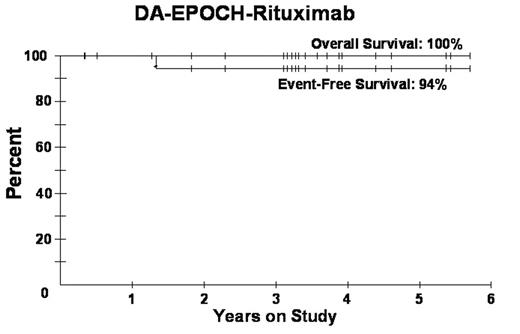Abstract
Gene expression profiling has revealed that over one third of genes more highly expressed in PMBL than other DLBCLs are characteristically expressed in classical Hodgkin Lymphoma (HL) suggesting a biological relationship (
J Exp Med198:851, 2003
). PMBL and HL also share mediastinal presentation, young age, female predominance, prominent sclerosis and CD30 expression. Although some cases lie in a pathological “grey zone” between HL and PMBL, the latter is distinguished by robust CD20 expression. Like HL, local mediastinal failure after doxorubicin-based regimens has led to routine mediastinal xRT, which is associated with secondary malignancies and coronary disease. We analyzed the outcome of DA-EPOCH in 36 untreated PMBLs. No pts received xRT except for CNS PMBL. DA-EPOCH was administered with G-CSF for 2 cycles beyond CR for 6 to 8 cycles as described (Blood99:2685, 2002
). The first 14 pts were on a DA-EPOCH study and the last 22 on a DA-EPOCH-Rituximab study. Most pts had adverse prognostic features with bulky disease, elevated LDH and extranodal sites, which were balanced among the 2 series. IHC in 34 cases was consistent with gene expression profiling of PMBL with frequent CD20+ 33/33 (100%), infrequent CD10+ 1/26 (4%) and variable BCL-6+ 17/24 (71%) and MUM-1+ 8/22 (36%) expression. Tumor proliferation by MIB-1 was high with a median (range) of 82% (54–98). IHC markers were similar among the 2 series. EFS and OS are shown below with a median follow-up of 8.6 and 3.4 yrs, respectively, for pts receiving DA-EPOCH −/+ R. Rituximab was associated with a significantly improved EFS (p=0.036) and trend in improved OS (p=0.10) by 2-tailed exact log-rank test. In conclusion, pt characteristics were consistent with the clinical-pathological and molecular definition of PMBL and prognostic features were similar to other series (Haematologica87:1258, 2002
). These results suggest for the first time that rituximab significantly improves the outcome of PMBL and that DA-EPOCH-R obviates routine mediastinal xRT. DA-EPOCH-R may be more effective than CHOP-based treatment because it overcomes high tumor proliferation and employs pharmacodynamic dosing. Although needing confirmation, our results suggest DA-EPOCH-R without xRT is highly effective for PMBL. Patient CharacteristicsPatient Characteristics
| Characteristics . | All Patients . | DA-EPOCH . | DA-EPOCH-R . |
|---|---|---|---|
| Total Patients | 36 | 14 | 22 |
| Gender (F/M) | 23/13 (1.77) | 9/5 (1.8) | 14/8 (1.75) |
| Median age, y (range) | 33 (12–70) | 34 (20–62) | 33 (12–70) |
| Median Mass cm (range) | 8.9 (3–16) | 8.4 (5.1–15.7) | 10 (3–16) |
| Bulky mass > 6 cm | 29 (83%) | 11 (85%) | 18 (82%) |
| ECOG PS > 1 | 4 (11%) | 2 (14%) | 2 (9%) |
| Stage III or IV | 15 (42%) | 7 (50%) | 8 (36%) |
| LDH > Normal | 26 (72%) | 12 (86%) | 14 (64%) |
| Extranodal sites | 20 (56%) | 7 (50%) | 13 (59%) |
| Pleural effusion | 9 (25%) | 3 (21%) | 6 (27%) |
| Characteristics . | All Patients . | DA-EPOCH . | DA-EPOCH-R . |
|---|---|---|---|
| Total Patients | 36 | 14 | 22 |
| Gender (F/M) | 23/13 (1.77) | 9/5 (1.8) | 14/8 (1.75) |
| Median age, y (range) | 33 (12–70) | 34 (20–62) | 33 (12–70) |
| Median Mass cm (range) | 8.9 (3–16) | 8.4 (5.1–15.7) | 10 (3–16) |
| Bulky mass > 6 cm | 29 (83%) | 11 (85%) | 18 (82%) |
| ECOG PS > 1 | 4 (11%) | 2 (14%) | 2 (9%) |
| Stage III or IV | 15 (42%) | 7 (50%) | 8 (36%) |
| LDH > Normal | 26 (72%) | 12 (86%) | 14 (64%) |
| Extranodal sites | 20 (56%) | 7 (50%) | 13 (59%) |
| Pleural effusion | 9 (25%) | 3 (21%) | 6 (27%) |
Author notes
Corresponding author
2005, The American Society of Hematology
2005



This feature is available to Subscribers Only
Sign In or Create an Account Close Modal